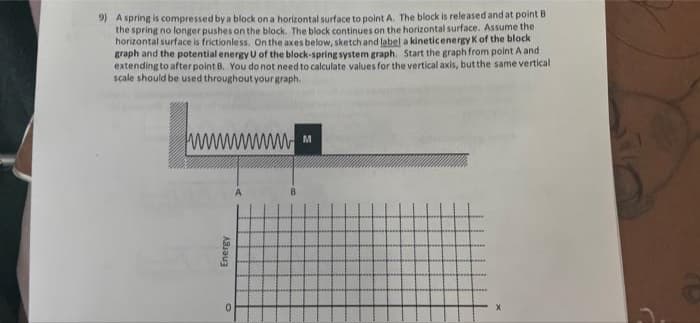9) A spring is compressed by a block on a horizontal surface to point A. The block is rele ased and at point B the spring no longer pushes on the block. The block continues on the horizontal surface. Assume the horizontal surface is frictionless. On the axes below, sketch and label a kineticenergy K of the block graph and the potential energy U of the block-spring system graph. Start the graph from point A and extending to after point B. You do not need to calculate values for the vertical axis, but the same vertical scale should be used throughout your graph. w wwM Energy
9) A spring is compressed by a block on a horizontal surface to point A. The block is rele ased and at point B the spring no longer pushes on the block. The block continues on the horizontal surface. Assume the horizontal surface is frictionless. On the axes below, sketch and label a kineticenergy K of the block graph and the potential energy U of the block-spring system graph. Start the graph from point A and extending to after point B. You do not need to calculate values for the vertical axis, but the same vertical scale should be used throughout your graph. w wwM Energy
Related questions
Question

Transcribed Image Text:9) Aspring is compressed by a block on a horizontal surface to point A. The block is released and at point B
the spring no longer pushes on the block. The block continues on the horizontal surface. Assume the
horizontal surface is frictionless. On the axes below, sketch and label a kineticenergy K of the block
graph and the potential energy U of the block-spring system graph. Start the graph from point A and
extending to after point B. You do not need to calculate values for the vertical axis, but the same vertical
scale should be used throughout your graph.
ww
w wM
Energy
Expert Solution
This question has been solved!
Explore an expertly crafted, step-by-step solution for a thorough understanding of key concepts.
Step by step
Solved in 2 steps with 1 images
